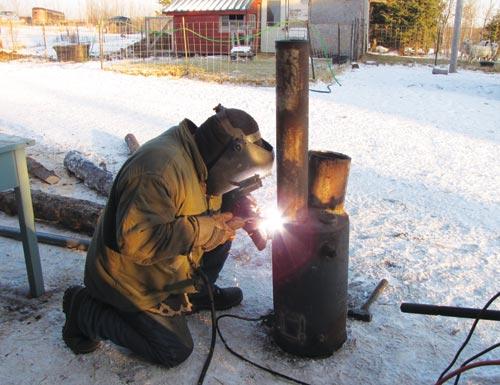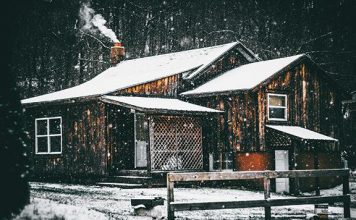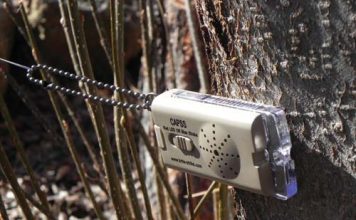 |
|
| Issue #138 • November/December, 2012 |
Keeping fresh water in front of our livestock in the winter has always been somewhat of a problem. A long time ago, when we lived on a homestead with electricity, we were able to keep an electric stock tank heater in our large stock tanks so that our cows and horses always had water to drink, no matter how cold it got. I built an insulated plywood box around our 150-gallon tanks with a lid on one half, also insulated. The animals drank from the open end, which also contained the floating stock tank heater. It worked pretty well, but boy-oh-boy was our electric bill huge during the winter!
Now we’ve lived off grid for more than 20 years. We have enjoyed each and every day except those frigid days when it was well below zero and we had to go out every morning and evening and chop several inches of ice off the top of our stock tanks. Then I’d scoop the large pieces of ice out of the water by hand. Nothing else seemed to work. I tried everything: pitchforks, ice fishing ice scoops, rubber gloves, and rakes, to name a few. My hands were frozen by the time I got back to the house.
Of course, being off grid, we couldn’t use an electric stock tank heater, even if we wanted to. There are propane stock tank heaters out there, but they are expensive and we are trying to free ourselves from buying any type of fossil fuel.
It got so bad during the winter that our big stock tanks would eventually freeze solid so there was no more room to put water. Now, three frozen solid 150 to 250-gallon stock tanks are impossible to thaw, chop, or otherwise use.
One day Will had a brainstorm. He remembered that his dad had told him about his life on the farm as a boy in northern Wisconsin. Every morning, he would have to light corncob fires in the wood-fired stock tank heaters for all the animals. He carried one bucket of corncobs, soaked in used oil, and another bucket of dry corncobs. He’d light an oil-soaked corncob, drop it into the heater, then drop in a few more cobs. While that was going, he’d go on to the other heaters in different tanks. Then he’d go back and add quite a few cobs to the first tank, which was by then burning well. In a few minutes, he was done with his chore and ready to go to school.
Could Will build a wood-fired stock tank heater for our homestead that would eliminate all that ice chopping?

[Above] (Prototype) Will shows how far the air inlet pipe will be inserted into the firebox
of the heater at left. [Below] Will welds the pipes onto the heater at right.

Prototype
Will’s first stock tank heater was built in about three hours. He’d found two 10-gallon electric water heaters at the dump. He brought them home and removed the outside jackets, old heating elements, and insulation. He chose one to work on and plugged all the pipe fittings. He then welded a 2×1½-inch square piece of 2-foot steel tubing over the opening where the heating element went into the bottom of the tank. After this, Will cut two holes in the top of the tank, one 4 inches and the other 6 inches in diameter and welded a 4×18-inch round steel pipe and a 6×12-inch round pipe flush with the top (with watertight welds).
He measured both pipes so that when the heater sat on the bottom of the tank, both pipes extended several inches above the water. (If your stock tank is a different size than ours, you’d need to take that into consideration when measuring your pipes.)
Will’s first tank was done. And we tried it with excitement. It worked! We fed small diameter wood in through both pipes. We kept it going all day and quite a few inches of the solid block of ice in our milk cow’s tank melted. We did this the next day and even more ice was gone.
But Will could see he needed to make improvements in the heater. Not enough air was getting to the fire and it smoked badly. Because it wasn’t burning efficiently, the fire wanted to smolder out. Time for retrofitting.

(Prototype) The tank is working well, but it’s floating!
Revisions
Will hauled the tank heater to the outside workbench and cut the square tube off with an acetylene torch and grinder. Then he added a steel patch over the hole. Cutting the 4-inch pipe free, he slid it down into the heater a little more than halfway and welded it in place on top. If the pipe is not put down in the heater far enough, it will act as a flue and the heater will just smoke and smolder most of the time.
To improve the draft on the heater and to allow us to put longer pieces of wood in the heater to let it self-feed, Will slid a two-foot section of 6-inch stove pipe into the 6-inch flue pipe. It helped a lot in both applications.
We put it back in the cow’s tank and fired it up. Much better! We had melted a lot of ice out of her tank, but when I filled the tank with the hose, the stock tank heater began to float like a cork.
When we had started out, the heater was on top of the ice. As it melted its way into the ice cake, more water was in the tank. As more water was in the tank, the heater tipped and floated more. Not good.
So Will let the fire go out and pulled the heater back out of the tank. We had several steel railroad spike plates in the scrap pile and he welded two of them on the bottom of the tank for weight. It worked nicely. We put the heater back in the cow’s tank and it sank. We still wired it to the fence, just to make sure our curious cows didn’t knock it over with their noses. It took quite a while to melt all the way down to the bottom of the tank as the heat rose. The more the ice melted, the more the heater sank into the water, so the ice melted faster and faster. If we had put the heater in the stock tank before it froze it would have been much more efficient. Now there is only relatively thin ice in the tank on top of the water in the morning following extremely cold nights. When the ice is broken and the fire started, that ice quickly melts.

(Second heater) The heater with patches and pipes in place, ready for stove pipe section, bottom plates and use in the horses’ stock tank
The second heater
We still had another stock tank full of ice and another 10-gallon electric water heater tank. Will quickly built another heater. Now that he had things figured out, this time it went much faster. Instead of putting plugs (costing $2.49 each!) in the pipe fittings, he cut around them and removed them, grinding the surface smooth with an angle grinder. We have a lot of small pieces of steel in our scrap pile, so he cut several pieces to fit the holes and welded them over the holes. It was much cheaper.
He then cut the two holes on top, one 4 inches and one 6 inches, for the air inlet and flue pipe. We already knew that it would float, so he added two more plates of steel on the bottom of the tank to give it more bottom weight. And he had seen how much better the heater worked after he added the 2-foot section of stove pipe to the 6-inch flue pipe, so he added that right away, too. All in all, this tank only took an hour and a half to build.
We took the tank down to the horses’ stock tank, which was a huge block of ice. Will chopped a slight bowl in the top of the ice with an ax, set the heater in it, and fired it up. In an hour, three inches of water were on top of the ice block. Now we have no more ice blocks in our stock tanks. And our wood-fired stock tank heater costs nothing to operate. We only burn “junk” wood or small diameter pieces of sapling that Will carefully saves from all of his clearing projects.

(Second heater) With the added weight of the steel plates, the heater stays submerged in the tank. Here, Will loads wood into the heater.
Notes for next time
On our first wood-fired stock tank heater, Will added a swinging door to the intake pipe to use as a damper. On the subsequent ones, he left this off but used David’s idea of a small piece of board as a damper instead. We discovered that the wood in the heater would last quite a bit longer and the fire would put more heat into the water instead of going up the chimney. So he added a damper to each of our stock tank heaters and they keep a fire better and heat the water quicker.
Will plans on adding one or two pieces of angle iron across the tank so he can attach the heater to the stock tank to hold it in place. The poly tanks will have to have a space between the heater and the side of the tank so the heat does not melt the stock tank.

(Second heater) Steel plates welded to the bottom of the tank give it enough weight to stay submerged.
Starting the wood-fired stock heater
When we started using our wood- fired heaters, we carefully wadded up some newspaper and stuffed it in the heater (without the stove pipe section on) then added some birch bark and fine kindling. Then we lit another wadded piece of newspaper and shoved it down into the flue pipe. This usually lit the kindling and we could slowly add some small, dry pieces of wood. This worked, but it did take time.
So we devised another way to speed things up. We have a propane weedburning torch that we use to start stubborn brush piles in newly-cleared pastures and other areas. Now we stick several pieces of wood down in the cold heater, in the 4-inch inlet pipe and several in the 6-inch flue in the morning, light the torch, put it in the 4-inch air inlet and fire it up. Instantly, it begins to roar and burn. We don’t need to leave the torch in there for long; usually the fire starts and is burning strongly in only a minute or so.
In 10 minutes, we can have both tanks heating very well. In an hour, the ice is all melted and the tanks are steaming like a hot tub. Of course the water is not hot it’s just cold outside. But the effect is impressive. The animals like it too. They are very smart about not getting burned on the heater or pipes.
We still have two more tanks we’d like to put heaters in for convenience. So we’re scouting the dump for more junked smaller electric water heaters. (Propane water heaters have a vent pipe in the center of the tanks so electric water heaters work better.)
What if you don’t know how to weld or don’t have a welder right now? It wouldn’t cost very much to have a local welder assemble one for you. With pictures, a good welder would spend less than two hours putting one together and the material can usually be scrounged or bought very cheaply at scrap iron dealers.
Of course, welding is a homesteading skill that really benefits both men and women. It isn’t hard and can even be learned through community education courses offered at local schools.
Stick one of Will’s wood-fired stock tank heaters in your stock tank and you’ll spend less money and enjoy winter chores much more! Even folks who do have electric power will appreciate this wonderful new old invention.

(Second heater) Firing the heater up with the propane weed torch.















thx for common sense idea. electric tank heaters fail often and cost a fortune in electricity.